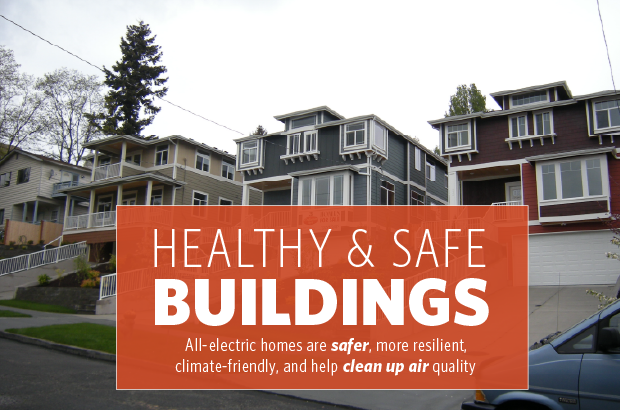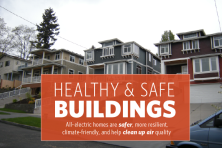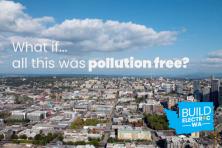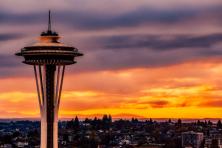Would you be surprised to learn that our homes and buildings dirty our air, outdoors and indoors? How is this possible? Even as we’ve worked to reduce our climate and air pollution by cutting down on vehicle use and using clean, fossil free sources for our electricity, we continue to use fossil fuels like fossil gas (still called “natural gas” by the gas industry) to heat and power our homes—raising our greenhouse gas emissions and dirtying our air.
Using gas not only damages our health, but puts our communities in harm’s way. We’re at risk of gas leaks and explosions—like the one in Seattle’s Greenwood neighborhood in 2016, which leveled two buildings, harmed 36 businesses, and created $3 million dollars of damage. While it’s fortunate that no people died in that particular explosion, using gas continues to put us in danger.
Washington and Oregon can do better to protect residents by creating clean, safe, all-electric buildings. In this second part of our blog series on all-electric buildings, we outline the health and safety risks of using gas, and detail how all-electric buildings can be the climate and health solution we need.
Little gas fires everywhere
Until recently, I had never considered how burning gas inside a home could create indoor air pollution. But similar to the smoke of any fire, cooking with gas emits pollutants even when our appliances are operating correctly. All of these pollutants—including nitrogen oxides (NOx), carbon monoxide (CO), fine particulate matter (PM 2.5), ultrafine particles, and formaldehyde—compromise indoor air quality. These pollutants can lead to respiratory, cardiovascular, and neurological health issues, including asthma, lung and breast cancer, heart failure, and premature death. Pollutants emitted by gas cooking appliances impact the respiratory and cardiovascular health of vulnerable populations such as children, seniors, and those with existing health conditions.
A recent UCLA study found that after one hour of cooking with gas, 90% of homes have indoor air quality that violates federal ambient air quality standards, meaning it would be illegal outside to emit that much outside. While proper ventilation can reduce some of these impacts, the reality is that many homes are poorly ventilated, with underused or lower functioning stove hoods. In fact, living in a home with gas cooking increases a child’s chance of developing asthma by 42%. The COVID-19 pandemic creates additional urgency to reduce the use of gas in buildings as soon as possible, as even small increases in long-term exposure to PM 2.5 leads to a large increase in the COVID-19 death rate, with more severe impacts to people over the age of 65.
Lastly, extracting and burning gas to heat our buildings also impacts our outdoor air quality. Babies born near natural gas flaring (common in fracking) are 50% more likely to be premature. While gas extraction doesn’t occur in Washington or Oregon, Washington buildings that use gas for heat and power release twice as much NOx into outside air as power plants do.
Environmental (in)justice
“The burden of air pollution is not evenly shared,” as the American Lung Association noted in their 2020 State of the Air report. Due to the historical practices of segregation and redlining, BIPOC (Black, Indigenous, and People of Color) communities have long been forced to live in places with greater concentrations of or exposure to air pollution. Similarly, fracking sites are often built on or near tribal nations or First Nations land.
Because of these factors, Black, Latinx, and Asian people, as well as people of lower socioeconomic status, already have higher risks of death from particle pollution. Lower-income households may also be at higher risk of exposure to gas pollution because of smaller housing unit sizes, more people per home, older homes with poorer ventilation, and using stoves or ovens for supplemental heat. Poor communities also may lack access to healthcare, grocery stores, and other resources that would help protect their health.
Keeping communities safe
From its use to its extraction, gas is dangerous. Running gas through pressurized pipelines can lead to gas leaks or explosions. In the United States, a gas pipeline kills someone, sends someone to the hospital, or causes a fire or explosion every four days. In Seattle, a 911 call is made every three days related to a suspected gas leak or odor. The impacts from transporting gas are also felt disproportionately—gas transmission pipelines frequently run through First Nations and tribal nations land where leaks and explosions harm indigenous communities.
Fracking creates health risks not only for surrounding communities, but for workers who remain unprotected by federal standards, as oil and gas industries are exempted from the labor regulations that prevent workplace explosions. Additionally, the temporary labor camps created at fracked gas sites, filled primarily with male workers who are heavily isolated, have increased sexual harassment and assault towards locals and have contributed to the epidemic of missing and murdered indigenous women (MMIW).
Lastly and particularly in the Northwest, earthquake risk is a major safety concern of gas use. Pipelines have a high risk of exploding during seismic activity with gas responsible for at least 20% of post-earthquake fire ignitions. All-electric buildings are more resilient following natural disasters as electricity can be restored more quickly than repairs can be made to ruptured gas lines.
The clean, affordable, climate solution we need
All-electric buildings will not only remove the air pollution caused by gas, but in fact will help us adapt to climate change. Highly efficient heat pumps used to heat all-electric buildings can also provide air conditioning. In-home cooling will be essential to keep vulnerable people safe during increasingly extreme and deadly heat waves or wildfires, especially for homes that otherwise would not be able to afford gas-powered air conditioning and for people who are bedridden, which puts them at the greatest risk of heat strokes. By constructing all-electric buildings, we’ll be creating a safer, healthier Pacific Northwest, particularly for frontline communities.
In our next post in this series, we’ll explore the cost savings for customers and the job creation opportunities by electrifying our buildings.





